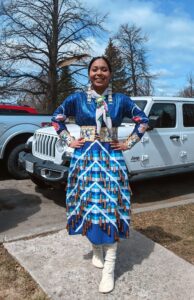‘Why We Dance’ Series: Aungelle Wabigwan
Everyone dances for a different reason. Some are just learning. Some feel that it’s a connection to their home and culture. Others dance for healing or to celebrate a personal triumph. And some are competitive dancers. Whatever the reason, our hearts lift up as we see them enter through the Eastern Doorway and join the circle. Pow-Wow dances are expressions of self and spirituality, history and culture. There are many different types of dances and many different styles of regalia to go with the dances. Dances tell important stories – both personal and cultural.
The Anishinabek News hopes this series brings you light and hope during these times of uncertainty, and inspiration to keep moving forward on your journey – whatever it may be; or maybe even dance.

By Aungelle Wabigwan, Namaygoosisagagun First Nation
Boozhoo!
Aungelle Wabigwan indizhinikaaz. Namaygoosisagagun bidoonji. My name is Aungelle Wabigwan and I am from Namaygoosisagagun First Nation. I am a contemporary Jingle Dress dancer; however, I also enjoy dancing old style. To me, my dancing represents the cultural revitalization and reclamation of my identity. I didn’t grow up with the powwow circle, yet I always knew it was where I belonged. It had been my dream to dance for years until I created my first Jingle Dress last year at the age of 21.
I am also a strong believer in the teaching, “To dance is to pray, and to pray is to heal”. My main reason for dancing is to pray for healing for myself and my family. The Jingle Dress was originally gifted to the Anishinaabek as a Healing Dress, which is why I knew it had to be my first regalia. As a second-generation Residential School Survivor, it is extremely important for myself to bring the good medicine of dancing into my family. My late chomish on my mother’s side, Tommy Quisses, was taken to McIntosh Residential School at the age of four (he lived to his 80th birthday this year). My mom’s side of the family has suffered great loss of not only our chomish/father, but of our late Devin Paavola, my cousin who was also a beloved son/brother/nephew/uncle (he lived to the age of 21). After Devin left to the Spirit World in 2017, I wanted more than ever to get myself into the circle to pray for my family’s healing. On my father’s side, we lost his mother, Elma Wabigwan, a little over a week before my chomish this year as well. Watching my parents lose a parent at the same time has only added fuel to my motivation to keep dancing in the Healing Dress.
The Jingle Dress has helped me in ways that words cannot describe. When I danced in the circle in regalia for the first time, it was like coming home. I finally found a place where I knew that my heart belonged and had been searching for my whole life. Regardless of the challenges I face, I now know that dancing will always be there. I hope to inspire others who may feel the need to dance in the circle. Regalia or no regalia, I encourage you to get out there and follow your heart!
Miigwetch for allowing me to share my story. It was very important for me to acknowledge my relations in the Spirit World as they are the ones who dance with me alongside our other ancestors. When I dance, I am proud to represent my families (Wabigwan/Boissoneau/Paavola) and my community (Namaygoosisagagun).


